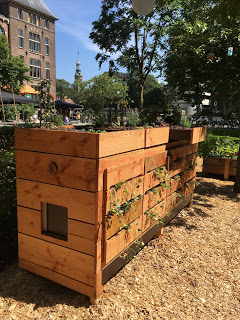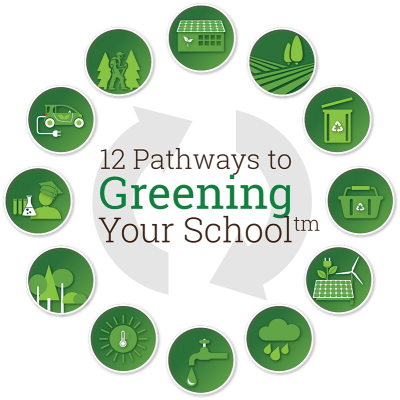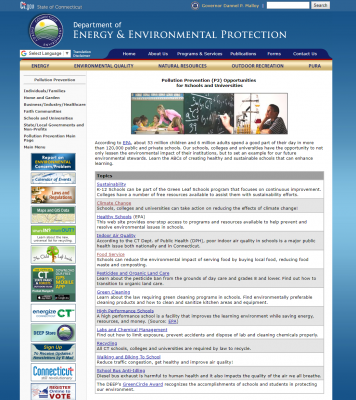At some point nearly every day, we hear the climate is changing. At times, climate change can feel like a faceless, unsolvable problem. However, there are many ways citizens can get involved in the fight for the environment.
Schools and universities are perfect incubators for major environmental initiatives. And, the Department of Energy and Environmental Protection (DEEP) in Connecticut has outlined numerous ways to get your own school or university involved.
The original web page is linked in the image above.
DEEP has provided many links on their “Pollution Prevention (P2)” Initiative page. Links include sites such as “The Green Guide for Universities”. This publication, provided by the International Alliance of Research Universities, outlines the struggles faced by institutions in their quest for sustainability, but more importantly, it provides solutions. From transport, to communication, to laboratories, “The Green Guide for Universities” covers it all. Campuses may even join the CT Alliance for Campus Sustainability, which serves as a network for universities with similar green goals. This would help your university develop a support system to lean on in their greening process. If you are a high school student, there are links for you, too. The CT Green Leaf Program provides resources and guides for high schools as they undertake sustainable initiatives. You can even check out these energy saving tips for your schools to reduce energy consumption. And, reducing energy consumption in your schools isn’t just good for the environment – it’s also good for your school’s budget! You could cut down on your schools utility bills by as much as 25% if everyone works together, according to the article. That means less money spent on electricity, and more money spent on after-school programs, course materials, art supplies, musical instruments, field trips – the list goes on! That is something worth fighting for!

Worried about food waste? DEEP has also provided links for instructions on how to start a compost program in your school. For inspiration on composting in space-efficient ways, visit the site of Le Compostier. Le Compostier is an Amsterdam-based composting business founded by Rowin Snijder. Snijder creates what he calls “Worm Hotels”, beautifully crafted compost bins with gardens planted on top. The compost bins create an aerobic environment, meaning they generate no smell as the food decomposes. The company is a testament to the fact that environmentally-friendly practices can also be aesthetically pleasing, space effective, and cost effective! The idea is easily adaptable to school environments. And, when you’re done, you have fertile, nutrient-dense soil to start a school vegetable garden!

A worm hotel in Oosterpark, Amsterdam. Image from Le Compostier blog, linked here.
Concerned about the food production side of your school’s kitchens? The state of Connecticut has already implemented Public Act 09-81 in 2009, which requires all schools implement environmentally-safe cleaning products in their sanitary practices. There can be a tricky balance between environmentally-friendly products and products which still sanitize surfaces effectively, so DEEP has provided techniques to identify how to effectively transition away from more harmful products, linked here.

Ready to start recycling? Encourage peers to get their heads in the game with RecycleMania, a competition for college and university recycling programs! The competition takes place for a period of 8 weeks each Spring Semester. Winners are chosen based on per capita recycling, highest percentage of total waste recycled, and least waste generated in total. General information on recycling is available here for high school students, and here for college students. Make recycling fun, encourage your peers, and be persistent! Even the small efforts make big impacts.
Two final links are websites helpful to high school students. First, Project Green Schools. Project Green Schools is an initiative that encourages students and faculty to lead their schools to a greener world. The website has many helpful resources for high school students, especially this article, “12 Pathways to Greening Your School”. They share curricula, guides, apps, games, and helpful links for all 12 pathways that both students and faculty may incorporate into their school environments. The pathways are numerous and flexible, including everything from ecosystems and biodiversity to transportation. A resource that is definitely worth a look! The second helpful link is Eco-Schools. Eco-Schools provides an article, “Seven Steps Towards an Eco-School”. The article outlines even more helpful information on carrying out environmental reviews, action plans, and monitoring and evaluation to ensure schools are successful in their sustainable action plans.
 Image from Project Green Schools, providing their 12 pathways to greening your school.
Image from Project Green Schools, providing their 12 pathways to greening your school.
Students spend so much time at school – why not make them a greener place? Learn more, get involved, and fight for the environment!

